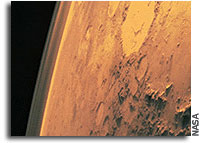Martian Carbon Dioxide Clouds Tied to Atmospheric Gravity Waves

On 4 March 1997 the Mars Pathfinder lander fell through the thin Martian atmosphere. During its descent, instrumentation aboard the lander recorded the changing atmospheric temperature, pressure, and density. Within this atmospheric profile, researchers identified anomalous cold air packets within the Martian mesosphere (60-90 kilometers, or 37-56 miles, altitude).
Later orbital measurements confirmed the existence of these cold pockets, adding to the mystery the detection of clouds made from carbon dioxide. Researchers in 1998 suspected that the cold air pockets, and thus conditions favorable for carbon dioxide condensation, were the product of atmospheric gravity waves in the Martian mesosphere. That hypothesis remained largely untested until advances in global- and intermediate-scale atmospheric models allowed Spiga et al. to confirm that gravity waves were a potentially viable mechanism to produce the necessary mesospheric conditions.
The authors find that gravity waves, produced in the model when wind rose up and over a mountain, could cause temperature variations in the mesosphere of up to 12 degrees Kelvin (21 degrees Fahrenheit). They suggest that this amount of cooling, if it happens to coincide with a larger atmospheric temperature shift, could push mesospheric temperatures a few degrees below the -80 degrees Celsius (-112 degrees Fahrenheit) condensation point of carbon dioxide. Combining the results of their smaller-scale model with those of a Martian general circulation model, the authors find that they can account for carbon dioxide cloud distribution patterns consistent with observational records.
Source: Geophysical Research Letters, doi: 10.1029/2011GL050343, 2012 http://dx.doi.org/10.1029/2011GL050343
Title: “Gravity waves, cold pockets and CO2 clouds in the Martian mesosphere”
Authors: A. Spiga and F. Forget: Laboratoire de Meteorologie Dynamique, Universite Pierre et Marie Curie, Institut Pierre-Simon Laplace, Paris, France; F. Gonzalez-Galindo and M.-A. Lopez-Valverde: Instituto de Astrofisica de Andalucia, Consejo Superior de Investigaciones Cientifica, Granada, Spain.
Contact:
Mary Catherine Adams
+1 (202) 777 7530
mcadams@agu.org








